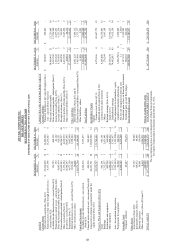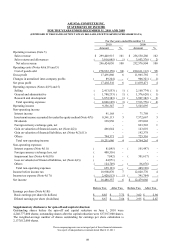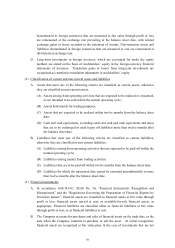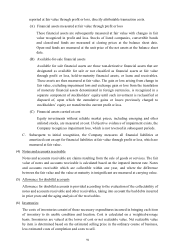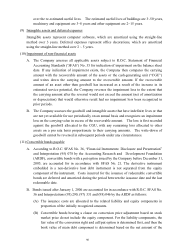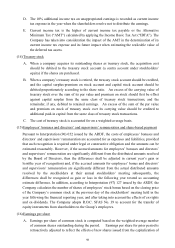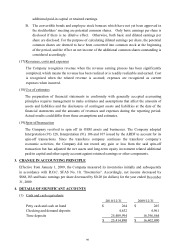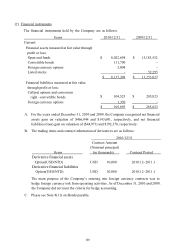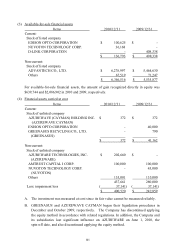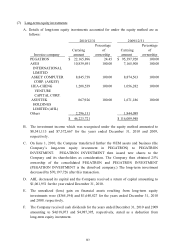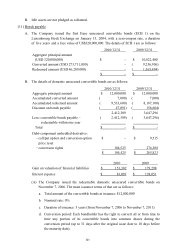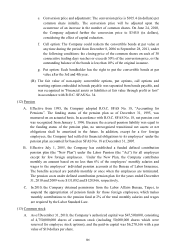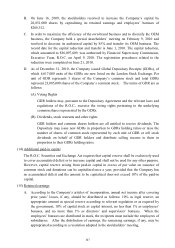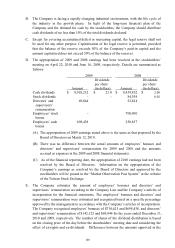Asus 2010 Annual Report Download - page 102
Download and view the complete annual report
Please find page 102 of the 2010 Asus annual report below. You can navigate through the pages in the report by either clicking on the pages listed below, or by using the keyword search tool below to find specific information within the annual report.
98
D. The 10% additional income tax on unappropriated earnings is recorded as current income
tax expense in the year when the shareholders resolve not to distribute the earnings.
E. Current income tax is the higher of current income tax payable or the Alternative
Minimum Tax (“AMT”) calculated by applying the Income Basic Tax Act (“IBTA”). The
Company has taken into consideration the impact of the AMT in the determination of its
current income tax expense and its future impact when estimating the realizable value of
the deferred tax assets.
(14) Treasury stock
A. When a company acquires its outstanding shares as treasury stock, the acquisition cost
should be debited to the treasury stock account (a contra account under stockholders’
equity) if the shares are purchased.
B. When a company’s treasury stock is retired, the treasury stock account should be credited,
and the capital surplus-premium on stock account and capital stock account should be
debited proportionately according to the share ratio. An excess of the carrying value of
treasury stock over the sum of its par value and premium on stock should first be offset
against capital surplus from the same class of treasury stock transactions, and the
remainder, if any, debited to retained earnings. An excess of the sum of the par value
and premium on stock of treasury stock over its carrying value should be credited to
additional paid-in capital from the same class of treasury stock transactions.
C. The cost of treasury stock is accounted for on a weighted-average basis.
(15)Employees’ bonuses and directors’ and supervisors’ remuneration and share-based payment
Pursuant to Interpretation (96) 052 issued by the ARDF, the costs of employees’ bonuses and
directors’ and supervisors’ remuneration are accounted for as expenses and liabilities, provided
that such recognition is required under legal or constructive obligation and the amounts can be
estimated reasonably. However, if the accrued amounts for employees’ bonuses and directors’
and supervisors’ remuneration are significantly different from the distributed amounts resolved
by the Board of Directors, then the differences shall be adjusted in current year’s gain or
loss(the year of recognition) and, if the accrued amounts for employees’ bonus and directors’
and supervisors’ remuneration are significantly different from the actual distributed amounts
resolved by the stockholders at their annual stockholders’ meeting subsequently, the
differences shall be recognized as gain or loss in the following year treated as accounting
estimate difference. In addition, according to Interpretation (97) 127 issued by the ARDF, the
Company calculates the number of shares of employees’ stock bonus based on the closing price
of the Company’s common stock at the previous day of the stockholders’ meeting held in the
year following the financial reporting year, and after taking into account the effects of ex-rights
and ex-dividends. The Company adopts R.O.C. SFAS No. 39 to account for the transfer of
equity instruments from shareholders to the Group’s employees.
(16)Earnings per share
A. Earnings per share of common stock is computed based on the weighted-average number
of common shares outstanding during the period. Earnings per share for prior period is
retroactively adjusted to reflect the effects of new shares issued from the capitalization of


